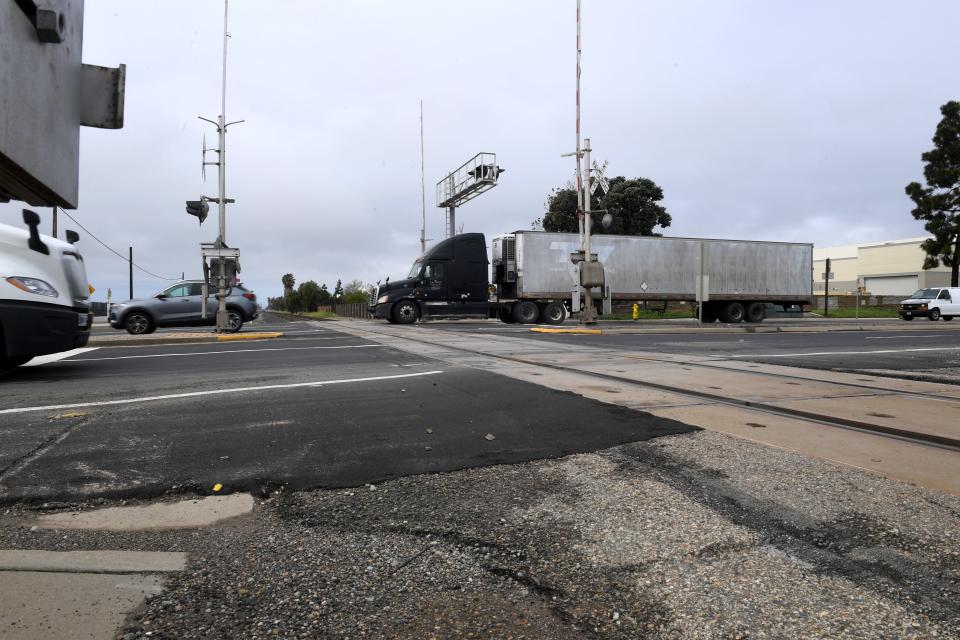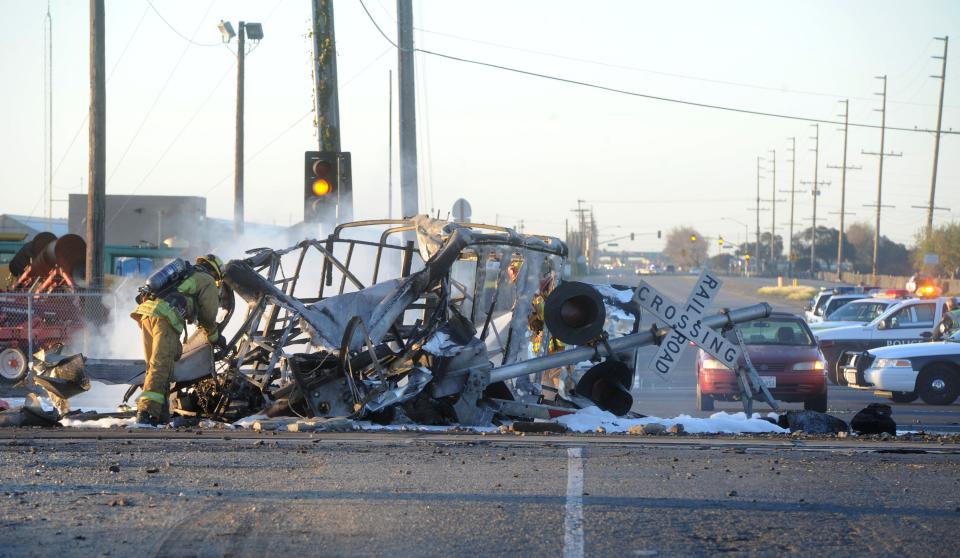Rice Avenue bridge over railroad tracks in Oxnard expected to open in 2028, cost $117M
Eight years after a deadly train crash in Oxnard, the city and Caltrans have the funding lined up for a $117 million bridge over the tracks that would prevent any future collisions of trains and vehicles.
The Rice Avenue railroad crossing has long been known as one of Ventura County's most dangerous, even before a 2015 crash between a truck and a Metrolink commuter train.
The bridge is set to be finished in 2028, but the city and Caltrans recently ran into a snag in acquiring some of the property they need.
Last month, the California Department of Transportation filed a lawsuit against the United Water Conservation District, a public agency that manages the Santa Clara River watershed, to take a small United Water property along Rice Avenue through eminent domain.
The city of Oxnard is overseeing the bridge project, but Caltrans is in charge of acquiring the property, because the project lies at the intersection of two state highways: Rice Avenue is Highway 1 in that area, and Fifth Street, which runs parallel to the railroad tracks, is Highway 34.
The United Water property is about a quarter of an acre, on the east side of Rice. Under it is a well that pumps water to farmers on the Oxnard Plain, when surface water from the river isn't available.
That well could co-exist with the new bridge, said Anthony Emmert, United Water's assistant general manager. But servicing the well during and after bridge construction would be tricky, and the agency wasn't able to reach an agreement with Caltrans to buy the property.

Eminent domain is the legal process through which a government agency can take property from an owner who doesn't want to sell. The agency taking the property still must pay for it, and the price is typically settled out of court or determined by a judge.
"Occasionally, you have to go in with equipment and a couple tractor-trailer rigs, and you need a footprint for that," Emmert said. "The portion they need is going to make it really tough to do that. ... We were hoping to negotiate with Caltrans so that when the project moves forward to construction, we could have an access road and a little space to do that kind of work, and we were not able to get that approval."
Caltrans offered only $5,000 for the property, Emmert said.
A Caltrans spokesperson refused to comment on the eminent domain lawsuit or confirm details about the price the agency offered.
"Caltrans is very sensitive over pesticide contamination on anything that used to be farmland or is close to farmland on the Oxnard Plain," he said. "According to their procurement rules, they can't offer more if there's any risk, even though we don't think there's a huge contamination risk there."
Plans move ahead
Debbie O'Leary, a transportation planner with the city of Oxnard, said she does not expect the eminent domain proceeding to slow down the project's overall timetable. The city is wrapping up the design phase now, she said. The state will probably release the construction funds in about a year, so the city plans to put the project out to bid then, with a four-year construction schedule.
The project involves moving Rice Avenue a little to the east, widening it and building a 416-foot, six-lane bridge so that the road passes over both Fifth Street and the railroad tracks.

"All those crossing arms will be removed. There will be no conflict anymore between drivers and trains at that location, and drivers won't have to stop and wait for the trains," O'Leary said.
The city won't know for sure whether there will be any road closures until the contractor is hired, she said. But long-term closures shouldn't be necessary, because the new bridge will be a little east of the current Rice Avenue, and the old stretch of road can stay open until the new one is finished.
An intersection where a road and railroad tracks cross is known as a "grade-level crossing." The arrangement is inherently dangerous, and the crossing at Rice has been identified as among the most dangerous in the state, with a long history of collisions, a few of them fatal.
After the 2015 crash — which killed a Metrolink engineer and injured more than 30 passengers — local, state and federal officials began planning an overpass bridge. Funding finally came together in 2018, through California's Proposition 1 ballot measure.
In the past five years, estimates of the project's cost have grown from $70 million to $117 million, but it remains fully funded, O'Leary said.
"A lot has changed since then," she said, including the costs of land, construction materials and labor.
Tony Biasotti is an investigative and watchdog reporter for the Ventura County Star. Reach him at tbiasotti@vcstar.com. This story was made possible by a grant from the Ventura County Community Foundation's Fund to Support Local Journalism.
This article originally appeared on Ventura County Star: Oxnard plans new bridge at site of deadly 2015 train crash

